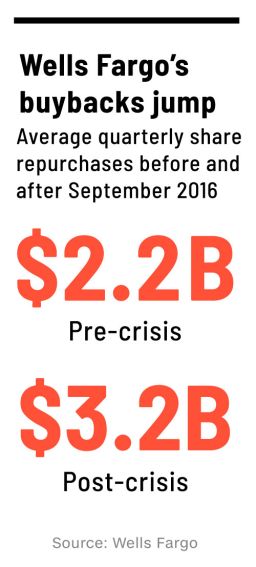Wells Fargo’s deposits and loans are under pressure from two years of scandal. It’s cutting up to 26,500 jobs and shutting hundreds of branches. And the bank’s stock price has trailed the rest of the market.
Despite those challenges — or perhaps because of them — Wells Fargo (WFC) has lavished shareholders with aggressive share buybacks.
Wells Fargo shelled out $7.4 billion to repurchase its stock in the third quarter, nearly triple what it spent the year before.

In the eight quarters since the fake-accounts scandal erupted in September 2016, Wells Fargo has spent an average of $3.2 billion each quarter on buybacks, according to a CNN Business review of company filings. That’s 45% above what the bank spent during the prior eight quarters.
Wall Street loves buybacks because they create demand for stocks. And by removing shares from the market, buybacks artificially boost companies’ earnings per share. Wells Fargo’s stock is down 24% in the past year, and it probably would be suffering more if the bank wasn’t going so big on buybacks.
“They can’t get new investors to buy the stock, so they’ll just get their own shareholders to do it,” said David Santschi, director of liquidity research at TrimTabs Investment Research. “They want to offset some of the loss of interest from the scandals.”
The Wells Fargo buyback splurge is far ahead of the ramp-up among Corporate America more broadly. Over that same timeframe, S&P 500 quarterly buybacks have increased on average by 12%, according to data provided by Howard Silverblatt of S&P Dow Jones Indices.
Brightest part of the Wells Fargo story
Big banks are ramping up buybacks across the board. The Federal Reserve has blessed a more robust capital return strategy from many large banks, freeing them to return some of the cash they’ve built up since the 2008 crisis.
S&P 500 financial sector quarterly buybacks, including those by Wells Fargo, rose by 34% over that time frame to $32 billion a quarter, according to S&P Dow Jones Indices.
Wells Fargo is expected to reveal another burst of buybacks when it reports quarterly results on Tuesday. Wall Street is counting on the buybacks to continue.
“This is the most positive part of the Wells Fargo story,” said Ken Leon, an analyst at CFRA Research who has a “sell” rating on the stock.
Wells Fargo declined to comment.
Up to 26,500 job cuts
While Wells Fargo has rewarded shareholders with stock buybacks, its workers are bracing for job cuts.
In September, Wells Fargo announced plans to cut as many as 26,500 jobs over three years as the bank grapples with the rise of online banking and hefty legal bills. The bank cited “changing customer preference,” including the wide adoption of digital banking.
“Instead of investing in frontline workers, they’re more concerned about shareholders and executive pay,” said Nick Weiner, organizing coordinator at the Committee for Better Banks. “They’re using their resources more to prop up their stock price, which you could argue is a conflict.”
Top execs paid mostly in stock
Critics see a conflict of interest because top executives are mostly paid in stock. That makes senior management a beneficiary of massive buyback plans that juice stock prices.
In 2017, 86% of Wells Fargo CEO Tim Sloan’s total compensation of $17.4 million was in long-term stock awards. At his own recommendation, Sloan did not receive a cash bonus.
Of course, paying executives in stock is designed to ensure their interests are aligned with shareholders. And defenders of buybacks see them as a legitimate way to return excess cash that can then be reinvested in the broader economy. JPMorgan Chase (JPM) CEO Jamie Dimon likes to remind critics that the money doesn’t simply disappear.
Besides doing buybacks, Wells Fargo has invested in its workforce in recent quarters. For example, in March 2018 Wells Fargo increased its minimum hourly pay rate by 11% to $15 for US-based employees. The bank also granted restricted stock awards to about 250,000 employees. Wells Fargo’s philanthropic donations were expected to top $400 million in 2018.
At the same time, Wells Fargo has also invested in technology. The bank has rolled out a number of new features, including real-time balance alerts, an online mortgage application and Control Tower, which is a hub to monitor customers’ digital financial footprints.
Wells Fargo remains in the penalty box
Wells Fargo’s third-quarter results suggest the bank is feeling the pain from two years of scandal and tough penalties from regulators. Deposits shrank by $40 billion, or 3%, over the prior year because consumers and businesses held lower balances.
And despite the strong economic growth during the third quarter, Wells Fargo’s loan book dipped by 1% as mortgages fell sharply. Other big banks, including JPMorgan Chase and Citigroup (C), posted solid loan growth in the third quarter.
Wells Fargo remains in the penalty box with the Federal Reserve, which last year imposed an unprecedented asset cap on the bank. The Fed slammed Wells Fargo for “widespread consumer abuse,” citing the millions of fake accounts opened by the bank, as well as thousands of borrowers who were charged for auto insurance they didn’t need and homebuyers who were hit with mortgage fees they didn’t deserve.
“The asset freeze plus management distraction means that Wells Fargo’s competitors can play offense while they’re handicapped addressing regulatory issues,” said Leon, the CFRA analyst.

























